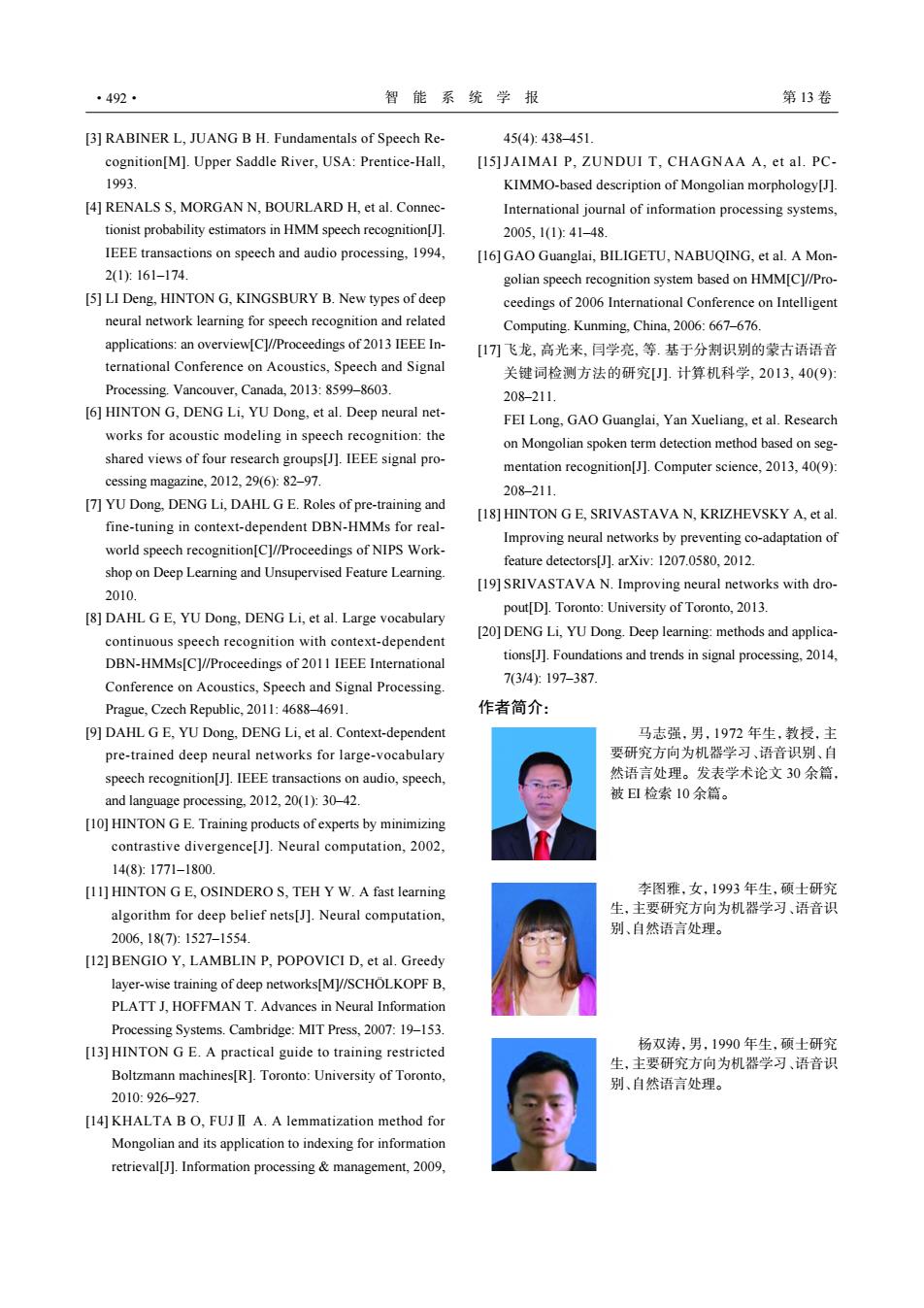正在加载图片...

·492· 智能系统学报 第13卷 [3]RABINER L,JUANG B H.Fundamentals of Speech Re- 45(4):438-451 cognition[M].Upper Saddle River,USA:Prentice-Hall, [15]JAIMAI P,ZUNDUI T,CHAGNAA A,et al.PC- 1993 KIMMO-based description of Mongolian morphology[J]. [4]RENALS S,MORGAN N,BOURLARD H,et al.Connec- International journal of information processing systems, tionist probability estimators in HMM speech recognition[J]. 2005,1(1:41-48. IEEE transactions on speech and audio processing,1994, [16]GAO Guanglai,BILIGETU,NABUQING,et al.A Mon- 2(1):161-174. golian speech recognition system based on HMM[C]//Pro- [5]LI Deng,HINTON G,KINGSBURY B.New types of deep ceedings of 2006 International Conference on Intelligent neural network learning for speech recognition and related Computing.Kunming,China,2006:667-676. applications:an overview[Cl//Proceedings of 2013 IEEE In- [1刀飞龙,高光来,闫学亮,等.基于分割识别的蒙古语语音 ternational Conference on Acoustics,Speech and Signal 关键词检测方法的研究J.计算机科学,2013,40(9): Processing.Vancouver,Canada,2013:8599-8603. 208-211. [6]HINTON G,DENG Li,YU Dong,et al.Deep neural net- FEI Long,GAO Guanglai,Yan Xueliang,et al.Research works for acoustic modeling in speech recognition:the on Mongolian spoken term detection method based on seg- shared views of four research groups[J].IEEE signal pro- mentation recognition[J].Computer science,2013,40(9): cessing magazine,2012,29(6):82-97. 208-211. [7]YU Dong,DENG Li,DAHL G E.Roles of pre-training and [18]HINTON G E,SRIVASTAVA N,KRIZHEVSKY A,et al fine-tuning in context-dependent DBN-HMMs for real- Improving neural networks by preventing co-adaptation of world speech recognition[C]//Proceedings of NIPS Work- feature detectors[J].arXiv:1207.0580,2012. shop on Deep Learning and Unsupervised Feature Learning. [19]SRIVASTAVA N.Improving neural networks with dro- 2010 [8]DAHL G E,YU Dong,DENG Li,et al.Large vocabulary pout[D].Toronto:University of Toronto,2013. [20]DENG Li,YU Dong.Deep learning:methods and applica- continuous speech recognition with context-dependent DBN-HMMs[C]//Proceedings of 2011 IEEE International tions[J].Foundations and trends in signal processing,2014. 7(3/4):197-387 Conference on Acoustics,Speech and Signal Processing. Prague,Czech Republic,2011:4688-4691. 作者简介: 9]DAHL G E.YU Dong,DENG Li,et al.Context-dependent 马志强,男,1972年生,教授,主 pre-trained deep neural networks for large-vocabulary 要研究方向为机器学习、语音识别、自 speech recognition[J].IEEE transactions on audio,speech, 然语言处理。发表学术论文30余篇, and language processing,2012,20(1):30-42. 被EI检索10余篇。 [10]HINTON G E.Training products of experts by minimizing contrastive divergence[J].Neural computation,2002. 148):1771-1800 [11]HINTON G E,OSINDERO S,TEH Y W.A fast learning 李图雅,女,1993年生,硕士研究 algorithm for deep belief nets[J].Neural computation, 生,主要研究方向为机器学习、语音识 别、自然语言处理。 2006,18(7):1527-1554. [12]BENGIO Y,LAMBLIN P,POPOVICI D,et al.Greedy layer-wise training of deep networks[M]//SCHOLKOPF B, PLATT J,HOFFMAN T.Advances in Neural Information Processing Systems.Cambridge:MIT Press,2007:19-153. [13]HINTON G E.A practical guide to training restricted 杨双涛,男,1990年生.硕士研究 生,主要研究方向为机器学习、语音识 Boltzmann machines[R].Toronto:University of Toronto, 别、自然语言处理。 2010:926-927 [14]KHALTA B O,FUJ II A.A lemmatization method for Mongolian and its application to indexing for information retrieval[J].Information processing management,2009,RABINER L, JUANG B H. Fundamentals of Speech Recognition[M]. Upper Saddle River, USA: Prentice-Hall, 1993. [3] RENALS S, MORGAN N, BOURLARD H, et al. Connectionist probability estimators in HMM speech recognition[J]. IEEE transactions on speech and audio processing, 1994, 2(1): 161–174. [4] LI Deng, HINTON G, KINGSBURY B. New types of deep neural network learning for speech recognition and related applications: an overview[C]//Proceedings of 2013 IEEE International Conference on Acoustics, Speech and Signal Processing. Vancouver, Canada, 2013: 8599–8603. [5] HINTON G, DENG Li, YU Dong, et al. Deep neural networks for acoustic modeling in speech recognition: the shared views of four research groups[J]. IEEE signal processing magazine, 2012, 29(6): 82–97. [6] YU Dong, DENG Li, DAHL G E. Roles of pre-training and fine-tuning in context-dependent DBN-HMMs for realworld speech recognition[C]//Proceedings of NIPS Workshop on Deep Learning and Unsupervised Feature Learning. 2010. [7] DAHL G E, YU Dong, DENG Li, et al. Large vocabulary continuous speech recognition with context-dependent DBN-HMMs[C]//Proceedings of 2011 IEEE International Conference on Acoustics, Speech and Signal Processing. Prague, Czech Republic, 2011: 4688–4691. [8] DAHL G E, YU Dong, DENG Li, et al. Context-dependent pre-trained deep neural networks for large-vocabulary speech recognition[J]. IEEE transactions on audio, speech, and language processing, 2012, 20(1): 30–42. [9] HINTON G E. Training products of experts by minimizing contrastive divergence[J]. Neural computation, 2002, 14(8): 1771–1800. [10] HINTON G E, OSINDERO S, TEH Y W. A fast learning algorithm for deep belief nets[J]. Neural computation, 2006, 18(7): 1527–1554. [11] BENGIO Y, LAMBLIN P, POPOVICI D, et al. Greedy layer-wise training of deep networks[M]//SCHÖLKOPF B, PLATT J, HOFFMAN T. Advances in Neural Information Processing Systems. Cambridge: MIT Press, 2007: 19–153. [12] HINTON G E. A practical guide to training restricted Boltzmann machines[R]. Toronto: University of Toronto, 2010: 926–927. [13] KHALTA B O, FUJⅡ A. A lemmatization method for Mongolian and its application to indexing for information retrieval[J]. Information processing & management, 2009, [14] 45(4): 438–451. JAIMAI P, ZUNDUI T, CHAGNAA A, et al. PCKIMMO-based description of Mongolian morphology[J]. International journal of information processing systems, 2005, 1(1): 41–48. [15] GAO Guanglai, BILIGETU, NABUQING, et al. A Mongolian speech recognition system based on HMM[C]//Proceedings of 2006 International Conference on Intelligent Computing. Kunming, China, 2006: 667–676. [16] 飞龙, 高光来, 闫学亮, 等. 基于分割识别的蒙古语语音 关键词检测方法的研究[J]. 计算机科学, 2013, 40(9): 208–211. FEI Long, GAO Guanglai, Yan Xueliang, et al. Research on Mongolian spoken term detection method based on segmentation recognition[J]. Computer science, 2013, 40(9): 208–211. [17] HINTON G E, SRIVASTAVA N, KRIZHEVSKY A, et al. Improving neural networks by preventing co-adaptation of feature detectors[J]. arXiv: 1207.0580, 2012. [18] SRIVASTAVA N. Improving neural networks with dropout[D]. Toronto: University of Toronto, 2013. [19] DENG Li, YU Dong. Deep learning: methods and applications[J]. Foundations and trends in signal processing, 2014, 7(3/4): 197–387. [20] 作者简介: 马志强,男,1972 年生,教授,主 要研究方向为机器学习、语音识别、自 然语言处理。发表学术论文 30 余篇, 被 EI 检索 10 余篇。 李图雅,女,1993 年生,硕士研究 生,主要研究方向为机器学习、语音识 别、自然语言处理。 杨双涛,男,1990 年生,硕士研究 生,主要研究方向为机器学习、语音识 别、自然语言处理。 ·492· 智 能 系 统 学 报 第 13 卷